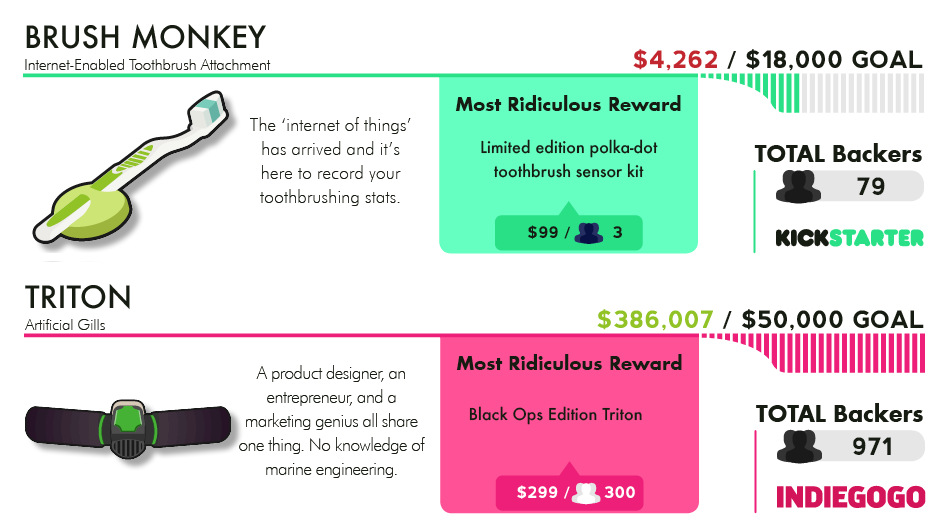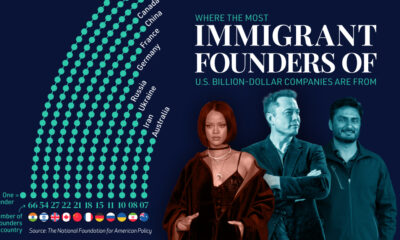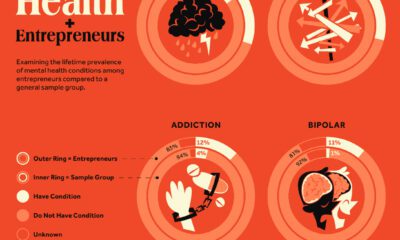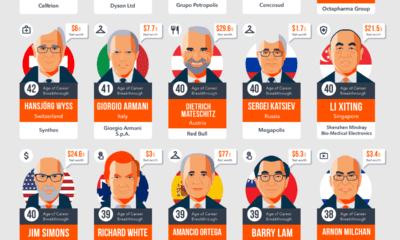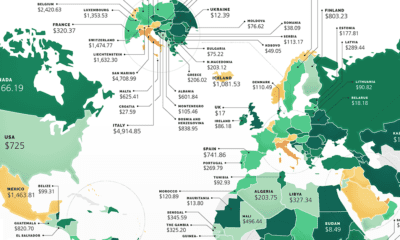Technology
19 Weird Crowdfunding Campaigns That Failed Spectacularly
Crowdfunding has been a game-changer for getting new products off the ground.
Platforms like Kickstarter or IndieGoGo have allowed aspiring entrepreneurs to get their ideas in front of millions, while generating invaluable amounts of buzz and publicity. Highly successful campaigns include products or proposals such as Ethereum, Oculus Rift, Pebble, or Star Citizen, which have combined to raise hundreds of millions of dollars in new capital.
However, because crowdfunding is open to everyone, not every campaign brings home the bacon. In reality, some campaigns are just plain strange or border on being nonsensical in nature.
Other ideas just bomb spectacularly. Either the concept has no product-market fit, or the prototype simply doesn’t do what it is supposed to do.
Weird Crowdfunding Fails
Today’s infographic comes from SSLs, highlighting 19 crowdfunding campaigns that were not destined to change the world in any meaningful capacity.
Note: These are all reward-based crowdfunding campaigns. Along the right-hand side of the infographic, it shows the platform used, amount raised, and the fundraising goal. Down the middle, it highlights the most ridiculous reward that was offered to backers, and how many people claimed the reward.

Where did some of these projects fall short? What can we learn from them?
Some projects such as the Induratus nuclear bunker were destined for failure because they were inherently selfish. The product could have been great, but if it doesn’t benefit the backers, it’s not going to take off. Sadly, the Induratus raised just $1, and as a result the project’s creator is now left very vulnerable to nuclear attacks.
The Triton, a set of artificial gills that could allow a user to breathe underwater, had the opposite problem. While the creators behind the project got the hundreds of thousands of dollars of funding they needed, the idea turned out to be scientifically impossible. In fact, the development of similar technology has eluded the world’s top scientists and military contractors for years. The group behind the product was forced to refund backers to the tune of $900,000.
Other projects were scientifically viable, while also solving a perceived market need. However, the problem with these products were that they did not serve a large enough market to make sense. The Sauceman’s Satchel is a good example of this.
While the creator loved the idea of a “convenient, carry-able, flyable, sauce transport” for camping and travel needs, the market overwhelmingly did not. That’s why it only raised about 40% of its funding goal from 105 backers. Now, the Sauceman Satchel is only serving sauce-lovers in product pitch heaven.
Technology
Visualizing AI Patents by Country
See which countries have been granted the most AI patents each year, from 2012 to 2022.

Visualizing AI Patents by Country
This was originally posted on our Voronoi app. Download the app for free on iOS or Android and discover incredible data-driven charts from a variety of trusted sources.
This infographic shows the number of AI-related patents granted each year from 2010 to 2022 (latest data available). These figures come from the Center for Security and Emerging Technology (CSET), accessed via Stanford University’s 2024 AI Index Report.
From this data, we can see that China first overtook the U.S. in 2013. Since then, the country has seen enormous growth in the number of AI patents granted each year.
| Year | China | EU and UK | U.S. | RoW | Global Total |
|---|---|---|---|---|---|
| 2010 | 307 | 137 | 984 | 571 | 1,999 |
| 2011 | 516 | 129 | 980 | 581 | 2,206 |
| 2012 | 926 | 112 | 950 | 660 | 2,648 |
| 2013 | 1,035 | 91 | 970 | 627 | 2,723 |
| 2014 | 1,278 | 97 | 1,078 | 667 | 3,120 |
| 2015 | 1,721 | 110 | 1,135 | 539 | 3,505 |
| 2016 | 1,621 | 128 | 1,298 | 714 | 3,761 |
| 2017 | 2,428 | 144 | 1,489 | 1,075 | 5,136 |
| 2018 | 4,741 | 155 | 1,674 | 1,574 | 8,144 |
| 2019 | 9,530 | 322 | 3,211 | 2,720 | 15,783 |
| 2020 | 13,071 | 406 | 5,441 | 4,455 | 23,373 |
| 2021 | 21,907 | 623 | 8,219 | 7,519 | 38,268 |
| 2022 | 35,315 | 1,173 | 12,077 | 13,699 | 62,264 |
In 2022, China was granted more patents than every other country combined.
While this suggests that the country is very active in researching the field of artificial intelligence, it doesn’t necessarily mean that China is the farthest in terms of capability.
Key Facts About AI Patents
According to CSET, AI patents relate to mathematical relationships and algorithms, which are considered abstract ideas under patent law. They can also have different meaning, depending on where they are filed.
In the U.S., AI patenting is concentrated amongst large companies including IBM, Microsoft, and Google. On the other hand, AI patenting in China is more distributed across government organizations, universities, and tech firms (e.g. Tencent).
In terms of focus area, China’s patents are typically related to computer vision, a field of AI that enables computers and systems to interpret visual data and inputs. Meanwhile America’s efforts are more evenly distributed across research fields.
Learn More About AI From Visual Capitalist
If you want to see more data visualizations on artificial intelligence, check out this graphic that shows which job departments will be impacted by AI the most.
-

 Mining1 week ago
Mining1 week agoGold vs. S&P 500: Which Has Grown More Over Five Years?
-

 Markets2 weeks ago
Markets2 weeks agoRanked: The Most Valuable Housing Markets in America
-

 Money2 weeks ago
Money2 weeks agoWhich States Have the Highest Minimum Wage in America?
-

 AI2 weeks ago
AI2 weeks agoRanked: Semiconductor Companies by Industry Revenue Share
-

 Markets2 weeks ago
Markets2 weeks agoRanked: The World’s Top Flight Routes, by Revenue
-

 Countries2 weeks ago
Countries2 weeks agoPopulation Projections: The World’s 6 Largest Countries in 2075
-

 Markets2 weeks ago
Markets2 weeks agoThe Top 10 States by Real GDP Growth in 2023
-

 Demographics2 weeks ago
Demographics2 weeks agoThe Smallest Gender Wage Gaps in OECD Countries
